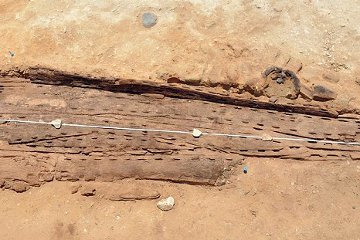Solar Boat at Abu Roash
| Abu Roash | 30 01 55.63N 31 04 29.81E | You can clearly see the outline of the pyramid complex with the hole for the burial chamber and a boat-shaped hole on the east. |
I have long been fascinated by Abu Roash, an isolated site that towers over the surrounding countryside in a way that the pyramids of Gizeh fail to do. However it isn't just the site that impresses: we are all familiar with the pharaohs who built the Gizeh pyramids - Khufu, Khafre, Menkaure - and most people just assume that each was the son of the preceding ruler. In fact Khafre was the grandson of Khufu; his father - Khufu's son - forsook the Gizeh plateau in favour of the isolated hill above Abu Roash.
And that wasn't all: Djedefre abandoned the technical advances made by his father's workmen in favour of an older style of pyramid. Instead of tunnelling into the rock to create a burial chamber, or building one high in the body of the pyramid, Djedefre excavated a huge T-shaped hole in the ground, a technique which went back to the time of the Step Pyramid!
Alas, Abu Roash was too conveniently placed for the builders of Cairo or perhaps its stone was more easily dislodged. Whatever the cause, travellers report seeing camel-loads of stone being removed from the pyramid and carried off to Cairo for building houses, palaces and mosques. However there is also evidence that Djedefre did not live very long and there is a good chance that in fact his pyramid was never completed and its present ruinous state is due to both the depredations of the stone robbers and the pharaoh's early death.
Very few tourists visit Abu Roash, perhaps another reason why the place feels special. If you can find a taxi driver who knows the way (or can ask the way) up onto the plateau, you get out a site where there are no ticket collectors, no Arabs offering camel rides or trying to sell you souvenirs you don't want, nothing apart from the heaps of stone. Of course, there are equally no notice boards, no information kiosks, no guide books, so you are really on your own as you explore the excavations that have been going on since the early 1900s.
Possibly the most impressive of the remains is the massive hole in the ground which ws to have been the burial chamber. The leg of the 'T' forms the ramp down into the hole and you can scramble down there and look up at the few stones left from the base of the pyramid which bridge the corner of the hole. Quite how they were going to completely cover it is not clear; either the hole itself would be filled in once the tomb chamber and its approach tunnels had been built, or some form of corbelling would have been employed. The examples of Saqqara and other similar pyramids point to the former method.
The boat pit, the most obvious other remnant, is just a rough boat-shaped hole in the ground. The stone up here is not the best quality and the sides of the hole are jagged. If there was ever a boat in here it has long vanished - and yet there is a boat up at Abu Roash!

| |
| A section of the 5,000 year old boat discovered at Abu Roash. |
French archaeologists working for the Frensh Institute of Oriental Archaeology have just announced (25 July 2012) the discovery of a wooden boat which they claim to be 5,000 years old. If so, there is not only the interest of the boat itself, but also the fact that Abu Roash must have been a burial site long before Djedefre chose it for his pyramid. According to Mohammed Ibrahim, the Antiquities Minister who has replaced the obnoxious Zahi Hawass, "This boat goes back to the era of Pharaoh Den, one of the First Dynasty kings."
The French, directed by Pierre Lacau, uncovered a series of mastabas to the east of the pyramid. Near one of these they uncovered eleven large wooden planks forming a boat 19' long and 4'6" wide. Much of the boat is missing, but it is clear that it is not nearly as large as the splendid boat found behind the Great Pyramid. Objects found near it bear the names of Pharaoh Den and Pharaoh Aha, both of the First Dynasty. Clearly more work needs to be done at Abu Roash to determine just what the connection is between these First Dynasty rulers and the site. Was there a pre-existing temple which Djedefre removed to make way for his pyramid? Or does the boat indicate the presence of a tomb?
The planks have been carefully transported to the Museum of Egyptian Civilisation where they are to be conserved. The plan is that they will go on display sometime next year, but it is highly unlikely that they will be displayed at Abu Roash. The site is just too isolated and lonely - no tourists would pay to see them and the locals might well cart them away for firewood. It is most likely that they will be displayed in the museum.
© Kendall K. Down 2012





